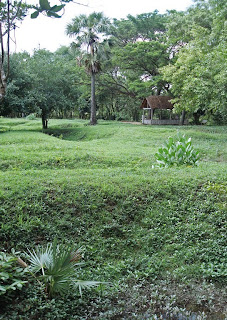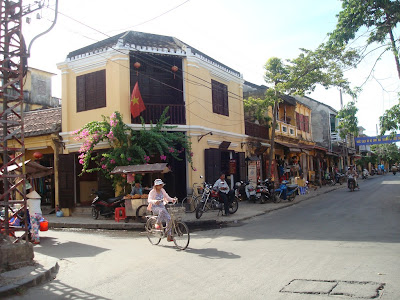 After a three hour bus journey from Ho Chi Minh City through the Vietnamese countryside, we arrived at the Cambodian border and almost didn't get past immigration. We both had e-visas and the only person who could use the computer had decided to throw a sickie on that day. We played dumb to their requests to return to Vietnam for a standard visa that would have cost us £50 extra and at least a couple of days mucking about in government offices. It took around half an hour before they finally got someone to turn on the computer and clear us through to the waiting bus to Phnom (nom) Penn.
After a three hour bus journey from Ho Chi Minh City through the Vietnamese countryside, we arrived at the Cambodian border and almost didn't get past immigration. We both had e-visas and the only person who could use the computer had decided to throw a sickie on that day. We played dumb to their requests to return to Vietnam for a standard visa that would have cost us £50 extra and at least a couple of days mucking about in government offices. It took around half an hour before they finally got someone to turn on the computer and clear us through to the waiting bus to Phnom (nom) Penn. Just outside Phnom Penn, we visited the Killing Fields, where much of the genocide took place in the late 1970's. Covering several acres, the now quiet open space is pitted with tens of square ditches that mark the site of mass graves, each containing hundreds of bodies of men, women and children. The area is also a marker for the hundreds of still undiscovered gravesites in the country. Walking around fragments of bone could be seen protruding in the path where the rain had washed away the earth.
One of the most shocking reminders of the events that took place is the killing tree, where soldiers held the feet and dashed the heads of babies against the tree until dead. This practice was more common than you would like to imagine; as ammunition became scarce,it was easier to execute the people with whatever was to hand: clubs, axes, picks, shovels and wooden staves were all used to kill the truckloads of people brought to the fields. As we walked into the centre of the area, we came to a Stupa containing thousands of the victim's skulls (8,000 to be precise) that loomed over the site like one large gravestone. We decided to skip the prison site tour and return to the hotel as the site of the killing fields was grim enough in itself.
 It's estimated that between two and three million people were murdered by the Khmer Rouge. That's one person killed, every minute of every hour, every day; for five years. At the start of the genocide, Cambodia had a population of 7 million people.
It's estimated that between two and three million people were murdered by the Khmer Rouge. That's one person killed, every minute of every hour, every day; for five years. At the start of the genocide, Cambodia had a population of 7 million people.Considering it's recent history and all the shit thrown at it, it's surprising that Cambodia even exists as a nation today at all. The Cambodians we met seemed to be a hardy lot, but behind the shy smiles that come often and the quiet eyes of the older people we saw and talked to, there is an undercurrent of events hidden away, unshared. Forgetting the past can't be easy, even for the younger generations. Corruption is rife right up to and including the current president; Many of the generals who run the country now are the same people who gave orders to kill in the Khmer Rouge; even brother number 1 Pol Pot escaped trial when he died of natural causes in 2007.
'F*ck you! F*ck you! You are going to die. F*ck you!' Sarah wasn't keen on going back to the riverfront after that.
However, there was a side to Phnom Penn that we liked. At the end of our trip and just before we flew to Bangkok we spent another day where we visited a great place called the Friends restaurant, which was run and staffed by former street kids. As well as being run for a good cause, this is one of the best restaurants for service and food we have found in south east Asia so far.
Kep was the next place we visited after our first stint in Phnom Penn. After four hours of bad Cambodian roads we were ready to relax in our jungle hillside retreat. We spent around a week in Kep Lodge enjoying chilling in the pool and watching some spectacular sunsets. We only left once to sample a bit of the world famous Kampot pepper and crab at one of the seafront restaurants. The pepper was so good Sarah, a lifelong hater of the black spice, is now a convert and can't get enough of the stuff.
We had a huge gecko living with us in our cottage. Apart from waking us up at night, it had the annoying habit of relieving itself from above and leaving large lizard turds for me to stand on in the morning - I let him off as I figured he must have been eating a good portion of the mosquitoes that were after our blood every night.
 We met some very nice people during our stay and on the last night we were up till late drinking with Bron, from Oz, and Nancy and John from England. We got to about 4am before we admitted defeat and went to bed. The next day Sarah, Bron and myself somehow managed to catch the early bus back to Phnom Penn. Bron is currently exploring Wales on the back of our advice, so we hope it isn't raining too much for her at home (fat chance).
We met some very nice people during our stay and on the last night we were up till late drinking with Bron, from Oz, and Nancy and John from England. We got to about 4am before we admitted defeat and went to bed. The next day Sarah, Bron and myself somehow managed to catch the early bus back to Phnom Penn. Bron is currently exploring Wales on the back of our advice, so we hope it isn't raining too much for her at home (fat chance). We traveled north to Siem Reap in the morning after sleeping the hangover off in Phnom Penn. Siem Reap is the choice to stay for most tourists as it is the closest town to Cambodia's first attraction, Angkor Wat and it's surrounding temples. We stayed in a fairly new hotel away from the main tourist area in Troang village, opposite the shack stilt houses on the river (more of a soupy-green open sewer than watercourse). Despite the smell coming from the water, the hotel was a great choice; Matt, the Australian owner was very open and honest about the good and bad of the place and gave us some great advice to get through all the temples. He won Sarah over straight away when he ordered her a bottle of Malborough Savignon Blanc for trade price. Also, being in the village was nicer than the tourist strip as you got more of a feel of everyday Cambodian life (in general, as laid back as possible - every house and shack comes with a hammock as standard).
You could easily spend a month trying to see all the temples of Angkor if you had the time, money and inclination, but three days was enough for us (sorry, me - Sar was all templed out by the first day and a half). We visited four different temples in all, including the sunrise over Angkor Wat. We enjoyed Angkor Wat, but our favourite places were The Bayon in Angkor Thom (which has the faces of the king and his monks carved into the pillars) and Ta Prohm. Ta Prohm is unique as it has been left as originally found, with strangler fig and cotton trees growing in and around the foundations and arches of the temples. Parts of the Tomb Raider and Indiana Jones movies were shot on location here and walking around the ruins you can see why. We were lucky as our Cambodian guide Kerry took us early and we had the place to ourselves, just avoiding the buses full of Korean tourists that were pouring in as we left.
Angkor Thom
Ta Prom (the 'Tomb Raider' strangler fig tree)
Here are a few more photos of our time in Cambodia.
Sunrise over Angkor Wat
Ta Prohm
Anyone for Cricket?
Faces of the Bayon, Angkor Thom
Our Tuk - Tuk driver, Mr. Li
Have a look at our new world food blog website The Food Atlas.com for world food recipes and stories.
Are you interested in food recipes from around the world? Have a look at www.thefoodatlas.com
Computer speed problems? www.systemoptimizer.org


















































